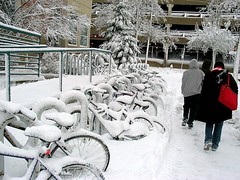Winter Riding
(Part One: CLOTHING)
We're finally into a fall weather pattern here in Oklahoma. This morning it was 53F as I drove to work and I was grateful for the car's heater. Yes, I drove to work. I've been fighting a sinus infection since Saturday. Between the constant headache and the chills, I really didn't feel up to being on the bike.
Sadly, many people put the bike away when the temperatures drop, but with a few key clothing items, cold weather cycling can be enjoyable.
Briefly, let's hit the high points. First, why would anyone want to ride in the cold? For big, 'thermally efficient' guys like me, cold weather is simply more comfortable. But if you've ever experienced the thrill of riding a bicycle along a snow-covered road just after dawn when the whole planet seems to be still and silent, almost as if holding its breath in anticipation of the coming day, you'll understand the fascination. The air seems crisp and clean. Your tires crunch across hard packed snow. Barking dogs and cars can be heard a long way off, yet the freshly fallen snow muffles their noises.
But you can't enjoy moments like this if you're freezing. Adding some items to your regular summer kit will extend the riding season well into the fall or even allow you to ride all winter. Let's cover the cold weather basics starting with the base layer. Long johns, both tops and bottoms, are a winter cycling essential. Avoid cotton because it will not keep you warm if you sweat, and believe me, you can still sweat copiously in cold temperatures. Get polypropylene, silk, or wool longs. There are different weights for different temperatures. You'll be comfy with a layer of warm, dry air next to your skin.
Next is the mid-layer, the insulation that retains body heat. Just like the base layer, there are different weights (or thicknesses if you prefer) so it's possible to tailor your mid-layer for the conditions. This takes some judgment and experience. Generally, if you start out feeling warm and comfortable, you'll feel like you're riding in a sauna before many miles have passed. I have a variety of thin, medium, and thick sweaters, as well as a couple of vests, allowing great versatility.
Cold weather comfort comes from layers of clothing. Wear two thin mid-layers rather than a single thick one if conditions warrant, especially if they're changeable. You can peel one off if you get too warm, so try to have something to carry it like a seat bag with a long strap or even a fanny pack or Camelback.
Your outer layer provides protection from rain and wind, and retains all that nice, warm air. I use simple nylon windbreakers and carry a separate rain jacket in a pannier. Goretex is an alternative, but I've been too tight to buy it. Besides, most of the Goretex clothing is either cycling-specific or seemingly built for mountaineering . There are some wind stopping fleece jackets that do an admirable job of providing both wind protection and some additional warmth. They're water resistant too, and probably a better choice in wet conditions that a simple nylon shell.
Up to this point, I haven't mentioned any winter clothing that's cycling-specific. There's one article of clothing that is indispensable, though, and that's a good pair of cycling tights. Worn over a pair of long johns, they'll keep you warm well below freezing. And just like long johns, they come in different weights. I like the bib double-front ones because they offer an extra layer over the chest.
For the first time, this winter I'll be using some overboots. My old cycling shoes were warm enough for most cold weather, but the new ones are much better ventilated. While that's a bonus when it's 100F in the summer, at the other end of the temperature scale, it's a big minus. I may try some other ways to keep my feet warm, like wearing two thin socks or even using those neoprene socks made for hunting. I'm a big fan of old-fashioned wool athletic socks, but they're getting hard to find.
You may think you need thick socks and heavy gloves to keep warm. Sometimes it's easier to simply wear a hat or a vest. The head is an excellent radiator because roughly a quarter of your blood flows through it. If you keep your head warm, the blood going to the extremities is warmer, thereby keeping your hands and feet warm. Likewise, if you think of your torso as the body's furnace, you can put on a vest and force more heat out to the extremities. Even a bandanna or scarf around your neck will help trap more heat under your jacket.
Another way to keep your face warm is to grow a beard and mustache for the winter. This only applies to part of the population, however. Motorists look horror-stricken when they see a cyclist with icicles hanging from his face!
If you commute in cold weather regularly, there may come a time when you look outside and see big, fat snowflakes drifting down, slowly covering the street with wet slush. Some weird part of your brain will insist that it's a good day for a ride. If this happens, it's time to consider engaging in the cold rain, mud, and perverse fascination of cyclocross.
Labels: winter cycling




2 Comments:
"thermally efficient" -- heh heh, I like that. ;-)
This comment has been removed by the author.
Post a Comment
<< Home